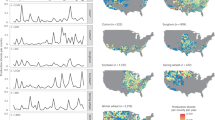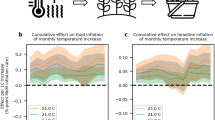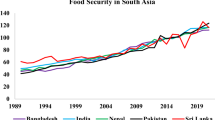Abstract
Recent price spikes1,2 have raised concern that climate change could increase food insecurity by reducing grain yields in the coming decades3,4. However, commodity price volatility is also influenced by other factors5,6, which may either exacerbate or buffer the effects of climate change. Here we show that US corn price volatility exhibits higher sensitivity to near-term climate change than to energy policy influences or agriculture–energy market integration, and that the presence of a biofuels mandate enhances the sensitivity to climate change by more than 50%. The climate change impact is driven primarily by intensification of severe hot conditions in the primary corn-growing region of the United States, which causes US corn price volatility to increase sharply in response to global warming projected to occur over the next three decades. Closer integration of agriculture and energy markets moderates the effects of climate change, unless the biofuels mandate becomes binding, in which case corn price volatility is instead exacerbated. However, in spite of the substantial impact on US corn price volatility, we find relatively small impact on food prices. Our findings highlight the critical importance of interactions between energy policies, energy–agriculture linkages and climate change.
This is a preview of subscription content, access via your institution
Access options
Subscribe to this journal
Receive 12 print issues and online access
$209.00 per year
only $17.42 per issue
Buy this article
- Purchase on Springer Link
- Instant access to full article PDF
Prices may be subject to local taxes which are calculated during checkout



Similar content being viewed by others
References
Wright, B. D. The economics of grain price volatility. Appl. Econom. Perspect. Policy 33, 32–58 (2011).
Abbott, P., Hurt, C. & Tyner, W. E. What’s Driving Farm Prices in 2011? (Farm Foundation, 2011).
Schlenker, W. & Roberts, M. J. Nonlinear temperature effects indicate severe damages to US crop yields under climate change. Proc. Natl Acad. Sci. USA 106, 15594–15598 (2009).
Battisti, D. S. & Naylor, R. L. Historical warnings of future food insecurity with unprecedented seasonal heat. Science 323, 240–244 (2009).
Anderson, K. & Nelgen, S. Trade barrier volatility and agricultural price stabilization. World Dev. 40, 36–48 (2011).
Hertel, T. W. & Beckman, J. in The Intended and Unintended Effects of US Agricultural and Biotechnology Policies (eds Zivin, J. G. & Perloff, J.) (NBER and Univ. Chicago Press, 2011).
Diffenbaugh, N. S. & Scherer, M. Observational and model evidence of global emergence of permanent, unprecedented heat in the 20th and 21st centuries. Climatic Change 107, 615–624 (2011).
USDA National Agricultural Statistics Service Quick Statshttp://quickstats.nass.usda.gov/ (2011).
Diffenbaugh, N. S. & Ashfaq, M. Intensification of hot extremes in the United States. Geophys. Res. Lett. 37, L15701 (2010).
Taheripour, F., Hertel, T. W. & Tyner, W. E. Implications of biofuels mandates for the global livestock industry: A computable general equilibrium analysis. Agr. Econom. 42, 325–342 (2011).
Energy Information Agency Annual Energy Outlook 2010 (EIA, US Department of Energy, 2010).
Diffenbaugh, N. S., Ashfaq, M. & Scherer, M. Transient regional climate change: Analysis of the summer climate response in a high-resolution, century-scale ensemble experiment over the continental United States. J. Geophys. Res. 116, D24111 (2011).
Ainsworth, E. A., Leakey, A. D. B., Ort, D. R. & Long, S. P. FACE-ing the facts: Inconsistencies and interdependence among field, chamber and modeling studies of elevated CO2 impacts on crop yield and food supply. New Phytol. 179, 5–9 (2008).
Leakey, A. D. B. Rising atmospheric carbon dioxide concentration and the future of C4 crops for food and fuel. Proc. R. Soc. B 276, 2333–2343 (2009).
Gohin, A. & Treguer, D. On the (de)stabilization effects of biofuels: Relative contributions of policy instruments and market forces. J. Agr. Res. Econom. 35, 72–86 (2010).
Ahmed, S. A., Diffenbaugh, N. S., Hertel, T. W. & Martin, W. J. Agriculture and trade opportunities for Tanzania: Past volatility and future climate change. Rev. Dev. Econom. (in the press).
National Research Council Renewable Fuel Standard: Potential Economic and Environmental Effects of US Biofuel Policy (NRC, 2011).
Thompson, W., Meyer, S. & Weshoff, P. The new markets for renewable identification numbers. Appl. Econom. Perspect. Policy 32, 588–603 (2010).
H.R. 3097: Renewable Fuel Standard Flexibility Act (112th Congress: 2011–2012) (United States House of Representatives, 2011).
Thompson, W. & Meyer, S. EPA mandate waivers create new uncertainties in biodiesel markets. Choices 26 (2011).
Pal, J. S. et al. Regional climate modeling for the developing world: The ICTP RegCM3 and RegCNET. Bull. Amer. Meteorol. Soc. 89, 1395–1409 (2007).
Collins, W. D. et al. The Community Climate System Model version 3 (CCSM3). J. Clim. 19, 2122–2143 (2006).
Diffenbaugh, N. S., Pal, J. S., Trapp, R. J. & Giorgi, F. Fine-scale processes regulate the response of extreme events to global climate change. Proc. Natl Acad. Sci. USA 102, 15774–15778 (2005).
IPCC Special Report on Emissions Scenarios (eds Nakicenovic, N. R. & Swart, R.) (Cambridge Univ. Press, 2000).
Ashfaq, M., Bowling, L. C., Cherkauer, K., Pal, J. S. & Diffenbaugh, N. S. Influence of climate model biases and daily-scale temperature and precipitation events on hydrological impacts assessment: A case study of the United States. J. Geophys. Res. 115, D14116 (2010).
Ashfaq, M., Skinner, C. B. & Diffenbaugh, N. S. Influence of SST biases on future climate change projections. Clim. Dynam. 36, 1303–1319 (2011).
Valenzuela, E., Hertel, T. W., Keeney, R. & Reimer, J. J. Assessing global computable general equilibrium model validity using agricultural price volatility. Am. J. Agr. Econom. 89, 383–397 (2007).
Beckman, J., Hertel, T. & Tyner, W. Validating energy-oriented CGE models. Energ. Econom. 33, 799–806 (2011).
Food and Agricultural Policy Research Institute of the University of Missouri US Biofuels Baseline: The Impact of Extending the $0.45 Ethanol Blenders Credit Report #07-11 (FAPRI, 2011).
Acknowledgements
We thank W. Schlenker for sharing his data and parameter estimates with us. We are grateful for insightful and constructive comments from participants in the International Agricultural Trade Consortium theme day and the Stanford Environmental Economics Seminar series. We thank NCEP for providing access to the NARR data set, and the PRISM Climate Group for providing access to the PRISM observational data set. We thank the Rosen Center for Advanced Computing (RCAC) at Purdue University and the Center for Computational Earth and Environmental Science (CEES) at Stanford University for access to computing resources. The research reported here was primarily supported by the US DOE, Office of Science, Office of Biological and Environmental Research, Integrated Assessment Research Program, Grant No. DE-SC005171, along with supplementary support from NSF award 0955283 and NIH award 1R01AI090159-01.
Author information
Authors and Affiliations
Contributions
N.S.D. designed and performed the climate modelling, designed the climate–yield–economic modelling approach, analysed the results and wrote the paper. T.W.H. designed the climate–yield–economic modelling approach, designed the economic modelling, analysed the results and wrote the paper. M.S. designed the climate–yield–economic modelling approach, performed the yield calculations and analysed the results. M.V. designed the climate–yield–economic modelling approach, performed the economic modelling, analysed the results and wrote the paper.
Corresponding author
Ethics declarations
Competing interests
The authors declare no competing financial interests.
Supplementary information
Rights and permissions
About this article
Cite this article
Diffenbaugh, N., Hertel, T., Scherer, M. et al. Response of corn markets to climate volatility under alternative energy futures. Nature Clim Change 2, 514–518 (2012). https://doi.org/10.1038/nclimate1491
Received:
Accepted:
Published:
Issue Date:
DOI: https://doi.org/10.1038/nclimate1491
This article is cited by
-
The role of climate change and urban development on compound dry-hot extremes across US cities
Nature Communications (2023)
-
The impact of 1.5 °C and 2.0 °C global warming on global maize production and trade
Scientific Reports (2022)
-
Statistically bias-corrected and downscaled climate models underestimate the adverse effects of extreme heat on U.S. maize yields
Communications Earth & Environment (2021)
-
Extreme climate events increase risk of global food insecurity and adaptation needs
Nature Food (2021)
-
Climate adaptation by crop migration
Nature Communications (2020)



